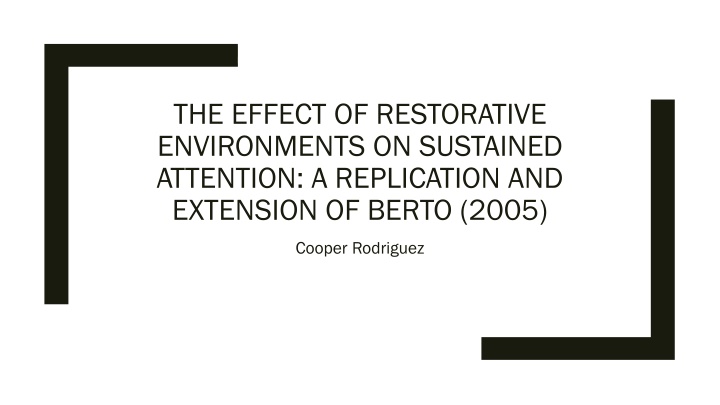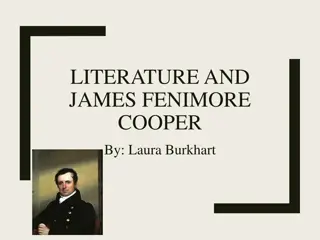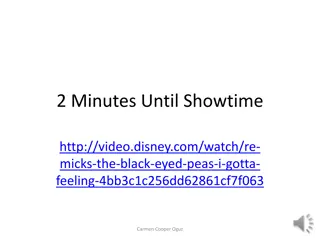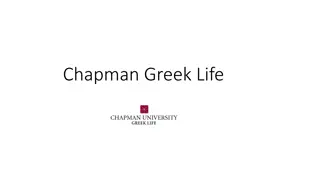
Enhancing Attention with Greyscale Restorative Environments
Explore the impact of greyscale images of restorative environments on sustained attention performance. Replicating and extending Berto's study, this research investigates if nature's restorative effects persist without color stimuli.
Download Presentation

Please find below an Image/Link to download the presentation.
The content on the website is provided AS IS for your information and personal use only. It may not be sold, licensed, or shared on other websites without obtaining consent from the author. If you encounter any issues during the download, it is possible that the publisher has removed the file from their server.
You are allowed to download the files provided on this website for personal or commercial use, subject to the condition that they are used lawfully. All files are the property of their respective owners.
The content on the website is provided AS IS for your information and personal use only. It may not be sold, licensed, or shared on other websites without obtaining consent from the author.
E N D
Presentation Transcript
THE EFFECT OF RESTORATIVE ENVIRONMENTS ON SUSTAINED ATTENTION: A REPLICATION AND EXTENSION OF BERTO (2005) Cooper Rodriguez
Background Nature s importance to humans Nature can: Improve affect/mood (Hartig et. al., 2003) Reduce physiological and psychological stress (Ulrich et al., 1991) Improve attention (Kaplan, 1995; Berman, Jonides, & Kaplan 2008; Berto, 2005)
Berto,2005 Experiment 1 Experiment 2 Experiment 3 Replication of experiment 1, but participants determined how long they would view the images Finding: performance was not significantly different between nature and urban which was due to participants choosing to not view the pictures as long as in experiment 1. Verify if restorative environments could improve performance on an attention task Determine whether and how geometric shapes will effect performance Finding: Geometric shapes did not have any performance effects Finding: Nature improved reaction time compared to urban.
Purpose Replicate and extend Berto (2005) Can we find the same restorative effects if we remove color from the image?
Question How will participants attention performance on the SART (Sustained Attention to Response Test) change if we greyscale the images presented to participants? Will nature still have a restorative effect on attention performance?
Method Pre-test post-test SART (Sustained Attention to Response Test) Restorative or nonrestorative exposure Urban original or greyscale Nature original or greyscale Control (geometric shapes) original or greyscale Berto, 2005.
Procedure Procedure SART Intervention SART Dependent Variable Dependent Variable Experimental Design Experimental Design Image Type Urban 1. d-prime participant's sensitivity in the detection of the target 2. Reaction time 3. Number of correct responses 4. Number of incorrect responses Nature Geometric C O L O R YES NO
Procedure Procedure SART Intervention SART Improved performance defined by 1. INCREASE d-prime participant's sensitivity in the detection of the target 2. DECREASE Reaction time 3. INCREASE Number of correct responses 4. DECREASE Number of incorrect responses Experimental Design Experimental Design Image Type Urban Nature Geometric Performed Better No Effect No Effect
Procedure Procedure SART Intervention SART Improved performance defined by 1. INCREASE d-prime participant's sensitivity in the detection of the target 2. DECREASE Reaction time 3. INCREASE Number of correct responses 4. DECREASE Number of incorrect responses Experimental Design Experimental Design C O L O R YES Improved performance No effect No effect Exploratory NO
Procedure Procedure SART Intervention SART Improved performance defined by 1. INCREASE d-prime participant's sensitivity in the detection of the target 2. DECREASE Reaction time 3. INCREASE Number of correct responses 4. DECREASE Number of incorrect responses Dependent Variable Experimental Design Experimental Design Image Type Urban Nature Geometric C O L O R YES Performed better No effect No effect Exploratory Exploratory Exploratory NO
Practical Application UN predicts by 2050 70% of the worlds population will live in an urban setting Study breaks on campus (Felsten, 2009) Recovery from surgery (Ulrich, 1984) Interior design for improving wellness (Ulrich, 1991) Baggage screening, air traffic controller, and additional applied vigilance tasks





















